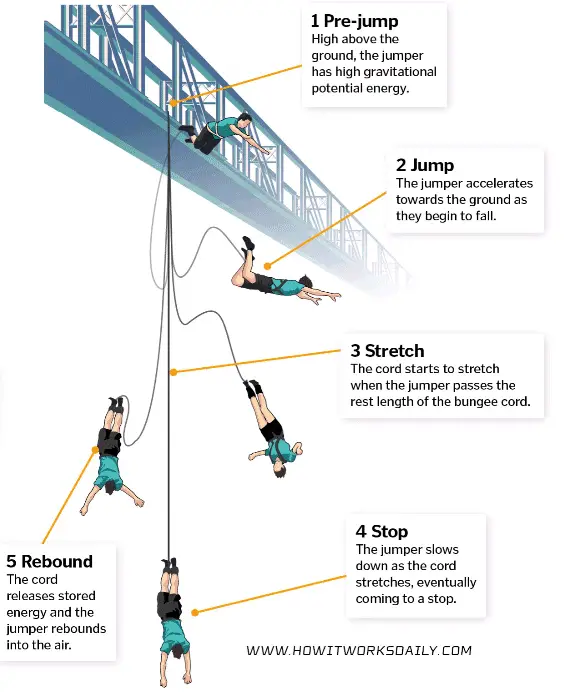When you bungee jump you not only put your life in the hands of the operators and equipment, but also the laws of physics. If you’re about to embark on your first bungee jump it’s only natural that you want to know how it all works.
It’s one of the most un-natural things you could ever wish to do. After all, you wouldn’t jump off a crane or bridge normally and your body and mind will do everything it can to dissuade you from doing it.
Handy Hint: If you are struggling with mentally preparing yourself for a bungee jump, read this guide for beginners with fear and anxiety.
In this guide I am not going to get into too much scientific detail on the physics of bungee jumping, but instead try to explain how it works in an easy to understand overview. I hope it will help you feel more comfortable about jumping for the first time. Here’s an infographic from the How It Works magazine if you want a quick visual explanation of how a bungee jump works.

How bungee jumping works
There are four main components you need to worry about; your weight, the cord, the harness, and then the jump itself. Here’s how they all combine to let you bungee jump safely.
1. Your weight
You will be weighed by the bungee operator, sometimes even twice. The reason for doing so is to let them calculate how much bungee cord they will need and double check you’re good to go.
Bungee cords are tested daily to a maximum weight limit. Because of that, it’s unlikely they will swap out a cord for you, as most people will jump from the same cord.
Handy Hint: I published a study to find out what the minimum and maximum weight limits are at the world’s most popular bungee jumping locations. You can read that in my guide to weight restrictions.
2. Bungee cord
Bungee cords are made from military grade rubber and fabrics. You can read more about how they are made further down the page, but simplistically it’s an elasticated cord.
It is tested to make sure that it cannot reach the floor when fully stretched at the maximum weight allowable.
The bungee cord will be securely attached to the jump platform using specialist equipment very similar to what’s used in the mountaineering world.
3. Harness
The bungee cord will then be connected to you using harnesses. Most commercial operators will use two harnesses; one attached to the ankle, and one to the body.
This means you have the security of having a back-up harness.

You now in the pre-jump phase and ready to go. At this point you have high gravitational potential energy… in other words, you will fall like a stone once you step off!
4. The jump
The operators will then connect your harnesses to the bungee cord. They will usually perform some final checks to ensure that the cord is the correct length based on your weight. Checks will also be made of the ankle and body harnesses.
As you step off the jump platform, you enter free fall. You will accelerate towards the ground at 9.8m/s2, with the velocity building…
Once the bungee cord is fully stretched you will start to slow due to the tension and will then start to recoil back up. You will bounce on the cord until all the tension has gone and the air resistance has brought you to a stop.
How does a bungee cord work?
As you jump from the platform you will be in immediate free-fall as gravity takes over. Your body will accelerate towards the ground. The rate of acceleration is 9.8m/s2. In simple terms that could mean you are falling at 43 mile per hour (70 km/h)!
Once the bungee cord has dropped to its un-stretched length, it will then start to stretch. It’s not just the gravity that makes the bungee cord stretch, but also the tension in the cord too.
Tension in the bungee cord create an upwards force which will then reverse the direction of the stretch… meaning you will start to recoil back up. During this retraction, the acceleration is starting slow as the tension in the cord reduces.
The tension in the cord will get less and less meaning you will bounce for a few times. The air resistance plays a huge part here, as without it you would actually bounce forever!
The air slows you down each time you bounce, until you come to a stop and the experience is over.
Handy Hint: Want to know what bungee jumping feels like? Click here for my own personal bungee jumping experience, plus stories from other jumpers.
What are bungee cords made of?
Commercial bungee cords are manufactured from strands of synthetic elasticated rubber. Most bungee cords can have almost 400 strands of rubber inside, all compacted together.
These strands are wound together and then have an external cotton outer core and polyester cover binding wrapped around them.
It’s actually the same cord that’s used in the military testing of rockets, so that should make it quite reliable!
Do they test bungee jump cords?
In the UK they do due to strict health and safety guidelines (you can read them here if interested). Each bungee cord will be checked daily by the operators. This is a manual process where they run the cords through their hands to check for any faults or imperfections.
Bungee cords are then de-commissioned after around one thousand bounces.
The operators will then test the bungee cord from the platform itself by placing heavy gym weights into a bag to mimic the 130 kg weight of a person. The bag will be dropped from a height of 55 meters.
Bungee cords can stretch over 3 times their own size!
Once the test has been completed with weights, a member of the team will then test it. They will jump and fall at 70 kilometres per hour!
You can see the test in this video from National Geographic.
How do you get back up after a jump?
This depends on the type of bungee jump. Some will lower you down to the ground, others will use pulleys to pull you back up to the platform. You can read more about the getting up or down in this article.
Has anyone died bungee jumping?
There are many instances of fatalities, but not as many as you might think. I published a study into bungee jumping deaths which shows how many have been recorded each year according to what I could find in the media.
The physics of bungee jumping
Obviously, there is so much more to the actual physics involved in a bungee jump. I am not a scientist, so can’t give you a physics lesson on all the factors at play.
However, I did find a website which explains all the forces at work and even includes some equations and formulas. If you are of a scientific mind, check out the Real World Physics website to see the complex explanation of how bungee jumping works.
Conclusion
And that’s the simple explanation for how bungee jumping works. Do you think you’ve got what it takes to take the plunge?

